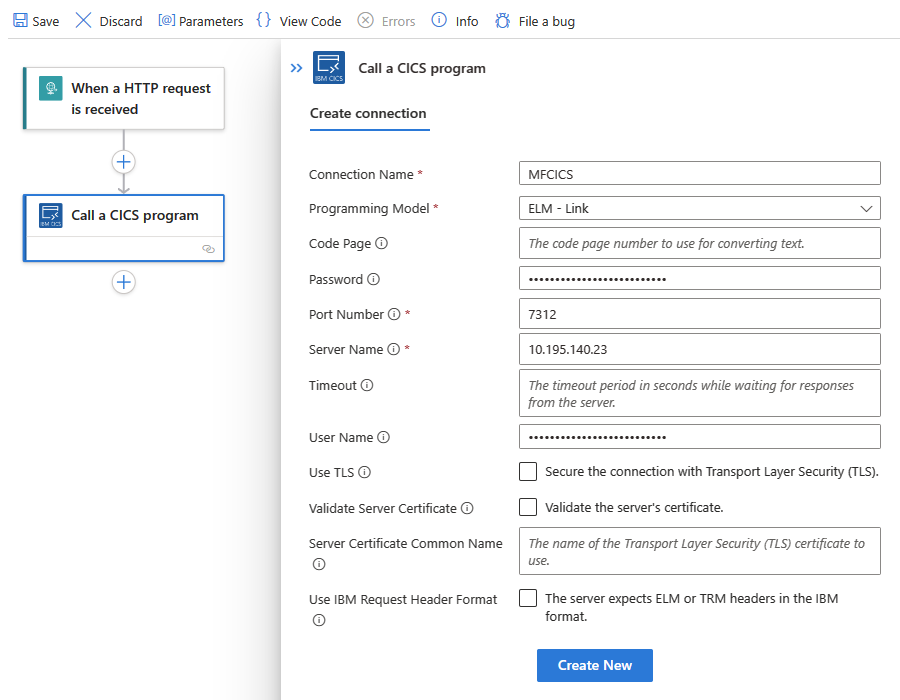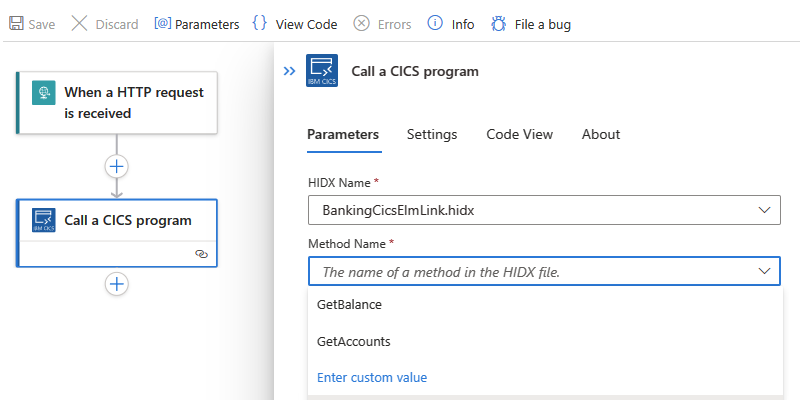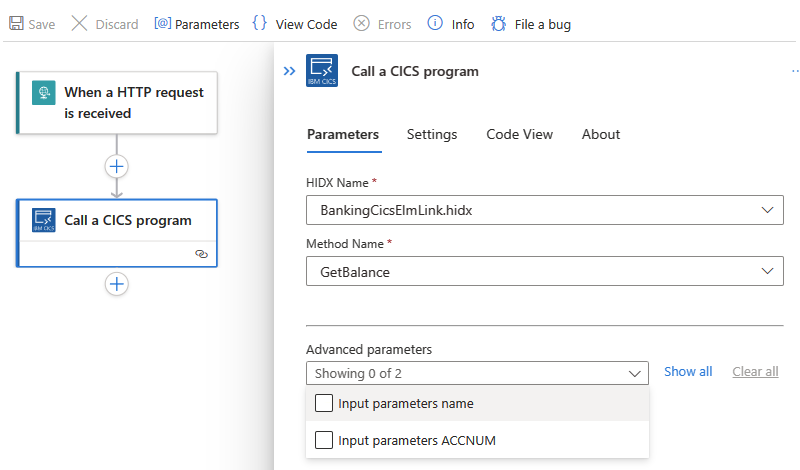Nota
O acesso a esta página requer autorização. Pode tentar iniciar sessão ou alterar os diretórios.
O acesso a esta página requer autorização. Pode tentar alterar os diretórios.
Aplica-se a: Aplicativos Lógicos do Azure (Padrão)
To access and run IBM mainframe apps on Customer Information Control System (CICS) systems from Standard workflows in Azure Logic Apps, you can use the CICS Program Call built-in, service provider-based connector. CICS provides a Transaction Program (TP) Monitor with an integrated Transaction Manager (TM). The connector communicates with IBM CICS transaction programs by using TCP/IP. The CICS connector is available in all Azure Logic Apps regions except for Azure Government and Microsoft Azure operated by 21Vianet.
This article describes the following aspects about the CICS connector:
- Scenarios for using the CICS connector in Azure Logic Apps
- Prerequisites and setup for using the CICS connector
- Steps for adding CICS connector actions to your Standard logic app workflow
Revise os cenários de uso do conector
CICS systems were one of the first mission-critical systems that run on mainframes. Microsoft Host Integration Server (HIS) provides connectivity to CICS systems using TCP/IP, HTTP, and APPC LU6.2. Customers have used the HIS Transaction Integrator to integrate CICS systems with on-premises Windows for many years. The CICS Program Call connector uses TCP/IP and HTTP programming models to interact with CICS transaction programs.
The following diagram shows how the CICS connector interacts with an IBM mainframe system:
To extend these hybrid cloud scenarios, the CICS connector in a Standard workflow works with the HIS Designer for Logic Apps, which you can use to create a program definition or program map of the mainframe transaction program. For this task, the HIS Designer uses a programming model that determines the characteristics of the data exchange between the mainframe and the workflow. The HIS Designer converts that information into metadata that the CICS connector uses when running an action in your workflow.
Depois de gerar o arquivo de metadados como um arquivo HIDX (Host Integration Designer XML) do HIS Designer, você pode adicionar esse arquivo como um artefato de mapa ao recurso do aplicativo lógico padrão. That way, your workflow can access your app's metadata when you add a CICS connector action. The connector reads the metadata file from your logic app resource, and dynamically presents parameters to use with the CICS connector in your workflow. You can then provide parameters to the host application, and the connector returns the results to your workflow. As a result, you can integrate your legacy apps with Azure, Microsoft, other apps, services, and systems that Azure Logic Apps supports.
Connector technical reference
Currently, one operation is available for the CICS connector: Call a CICS program. The following table summarizes the usage for this action:
| Parâmetro | Obrigatório | Tipo | Descrição |
|---|---|---|---|
| HIDX Name | Yes | Cordão | Select the CICS HIDX file that you want to use. |
| Nome do método | Yes | Cordão | Select the method in the HIDX file that you want to use. |
| Parâmetros avançados | Não | Varies | This list appears after you select a method so that you can add other parameters to use with the selected method. The available parameters vary based on your HIDX file and the method that you select. |
This operation also includes advanced parameters, which appear after you select a method, for you to select and use with the selected method. These parameters vary based on your HIDX file and the method that you select.
Pré-requisitos
Uma conta Azure e uma assinatura. Se não tiver uma subscrição do Azure, inscreva-se para obter uma conta do Azure gratuita.
Access to the mainframe that hosts the CICS system.
The Host Integration Designer XML (HIDX) file that provides the necessary metadata for the CICS Program Call connector to execute your mainframe program.
Para criar esse arquivo HIDX, baixe e instale o HIS Designer for Azure Logic Apps. O único pré-requisito é o Microsoft .NET Framework 4.8.
To invoke a mainframe program, your workflow needs to understand the mainframe program's type, parameters, and return values. The CICS connector manages this process and data conversions. The conversions provide input data from the workflow to the mainframe program and send any output data generated from the mainframe program to the workflow. The connector also provides tabular data definition and code page translation. For this process, Azure Logic Apps requires that you provide this information as metadata.
Para criar esses metadados, use o HIS Designer for Logic Apps. With this tool, you can manually create the methods, parameters, and return values that you use in your workflow. You can also import COBOL or RPG program definitions (copybooks) that provide this information.
The tool generates a Host Integration Designer XML (HIDX) file that provides the necessary metadata for the connector. If you're using HIS, you can use the HIS Transaction Integrator (TI) Designer to create the HIDX file.
The Standard logic app workflow where you want to integrate with the CICS system.
The CICS connector doesn't have triggers, so use any trigger to start your workflow, such as the Recurrence trigger or Request trigger. You can then add the CICS connector actions. Para começar, crie um fluxo de trabalho em branco no recurso do aplicativo lógico padrão.
Limitações
Currently, the CICS connector requires that you upload your HIDX file directly to your Standard logic app resource, not an integration account.
Definir e gerar metadados
Depois de baixar e instalar o HIS Designer para Aplicativos Lógicos do Azure, siga estas etapas para gerar o arquivo HIDX a partir do artefato de metadados.
Carregue o arquivo HIDX
Para que seu fluxo de trabalho use o arquivo HIDX, siga estas etapas:
Vá para a pasta onde você salvou o arquivo HIDX e copie o arquivo.
No portal do Azure, carregue o arquivo HIDX como um mapa para seu recurso de aplicativo lógico padrão.
Continue to the next section to add a CICS action to your workflow.
Later in this article, when you add a CICS Program Call connector action to your workflow for the first time, a prompt asks you to create a connection between your workflow and the mainframe system. After you create the connection, you can select your previously added HIDX file, the method to run, and the parameters to use.
Add a CICS action
Follow these steps to add a CICS action and configure the necessary parameters:
In the Azure portal, open your Standard logic app resource and workflow in the designer.
Se você não tiver um gatilho para iniciar seu fluxo de trabalho, siga estas etapas gerais para adicionar o gatilho desejado.
This example continues with the Request trigger named When a HTTP request is received:
To add a CICS connector action, follow these general steps to add the CICS Program Call built-in connector action named Call a CICS Program.
After the connection details pane appears, provide the following information, such as the host server name and CICS system configuration information:
Parâmetro Obrigatório Value Descrição Nome da Ligação Yes < nome da conexão> O nome da sua ligação. Programming Model Yes < CICS-programming-model> The selected CICS programming model. For more information, see Programming Models. Página de código Não < página de código> The code page number to use for converting text. Senha Não < palavra-passe> The optional user password for connection authentication. Port Number Yes < port-number> The port number to use for connection authentication. Nome do Servidor Yes < server-name> The server name. Tempo limite Não < time-out> The time-out period in seconds while waiting for responses from the server. Nome de Utilizador Não < nome de utilizador> The optional username for connection authentication. Use TLS Não True or false Secure the connection with Transport Security Layer (TLS). Validate Server certificate Não True or false Validate the server's certificate. Server certificate common name Não < server-cert-common-name> The name of the Transport Security layer (TLS) certificate to use. Use IBM Request Header Format Não True or false Direct the server to expect ELM or TRM headers in the IBM format. Por exemplo:
Quando terminar, selecione Criar novo.
Depois que o painel de detalhes da ação for exibido, na seção Parâmetros , forneça as informações necessárias:
Parâmetro Obrigatório Value Descrição HIDX Name Yes < Nome do ficheiro HIDX> Select the CICS HIDX file that you want to use. Nome do método Yes < method-name> Select the method in the HIDX file that you want to use. Parâmetros avançados Não Varies This list appears after you select a method so that you can add other parameters to use with the selected method. The available parameters vary based on your HIDX file and the method that you select. Por exemplo:
Select HIDX file and method
Select advanced parameters
Quando terminar, salve seu fluxo de trabalho. Na barra de ferramentas do estruturador, selecione Guardar.
Testar o fluxo de trabalho
Follow these steps to check your workflow and confirm the outputs:
Para executar seu fluxo de trabalho, na barra de ferramentas do designer, selecione Executar>Executar.
Depois que a execução do fluxo de trabalho terminar, o histórico de execução do fluxo de trabalho será exibido. Successful steps show check marks, while unsuccessful steps show an exclamation point (!).
Para revisar as entradas e saídas de cada etapa, expanda essa etapa.
Para rever as saídas, selecione Ver saídas brutas.
Conteúdo relacionado
- Verificar o status do fluxo de trabalho, exibir o histórico de execução e configurar alertas nos Aplicativos Lógicos do Azure
- Exibir métricas de integridade e desempenho do fluxo de trabalho nos Aplicativos Lógicos do Azure
- Monitorar e coletar dados de diagnóstico para fluxos de trabalho nos Aplicativos Lógicos do Azure
- Habilitar e exibir telemetria aprimorada em fluxos de trabalho do Application Insights for Standard em Aplicativos Lógicos do Azure




